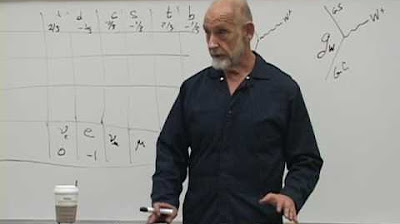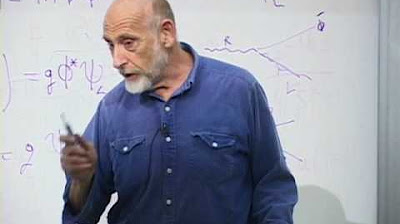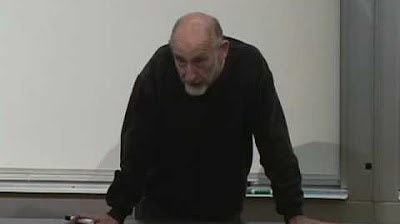Lecture 5 | New Revolutions in Particle Physics: Standard Model
TLDRThe video script from Stanford University delves into the intricacies of particle physics, focusing on gauge theories and their fundamental role in understanding the forces of nature. It explains quantum electrodynamics and quantum chromodynamics, highlighting the concept of gauge symmetry without delving too deeply into the mathematics. The script provides an overview of the electromagnetic field, discussing its properties and how it's represented by the four-vector potential. It also touches on the sources of the electric field, namely electric charges, and the conservation of charge as a consequence of gauge theory. The lecturer further explores the quantum mechanical description of electromagnetic waves in terms of photons and their polarization. The script also contrasts electrodynamics with quantum chromodynamics, emphasizing the strong coupling of gluons and the complex interactions within the color force. It concludes with a discussion on the weak interactions, the role of W bosons, and the historical context of force discovery in particle physics, leaving the audience intrigued about the reasons behind the slow decay rates associated with weak interactions.
Takeaways
- 📐 **Gauge Theories**: The script discusses gauge theories, which are fundamental to understanding forces in nature, including quantum electrodynamics and quantum chromodynamics.
- 🌌 **Maxwell's Theory**: Maxwell's theory of electromagnetism is introduced as the simplest gauge theory, describing fields with properties of the electromagnetic field.
- 🧲 **Electromagnetic Field**: The electromagnetic field is characterized by six components, three electric and three magnetic, which can be represented by a four-vector known as the vector potential.
- 🤝 **Interactions and Conservation Laws**: Gauge fields are associated with conservation laws, which are linked to symmetries, an essential aspect of gauge theories.
- 🤔 **Quantum Chromodynamics (QCD)**: QCD is a more complex gauge theory dealing with the strong interactions between quarks and gluons, based on the SU(3) group.
- 🚴♂️ **Color Charge in QCD**: Unlike electric charge, color charge in QCD is self-interacting, leading to phenomena like the confinement of quarks within hadrons.
- 🔵 **Leptons and Quarks**: The script outlines the properties of leptons and quarks, which are grouped into doublets under the SU(2) symmetry, relevant to weak interactions.
- 💥 **Weak Interactions**: Weak interactions, responsible for processes like beta decay, are slower due to the large mass of the W and Z bosons, which mediate these interactions.
- 🔋 **Neutrino and Electron**: The electron and neutrino are part of a doublet under the weak interaction's SU(2) symmetry, allowing for transitions like electron to neutrino via W- boson emission.
- 🧲 **Gluons and Color**: Gluons, the gauge bosons of QCD, carry color charge and can interact with each other, unlike photons which do not interact with each other.
- ⏱️ **Time Scales in Physics**: Different physical processes have distinct time scales, from the transit time of light across an atom to the decay time of particles, influenced by the fine-structure constant.
Q & A
What are gauge theories and why are they significant in physics?
-Gauge theories are a class of field theories that incorporate gauge symmetry, which is a form of invariance. They are significant because they describe three of the four known fundamental forces in the universe (electromagnetic, weak, and strong nuclear forces) and are the foundation of the Standard Model of particle physics.
What is the role of the gauge field in gauge theories?
-The gauge field is a field that is associated with gauge bosons, which are the carriers of the fundamental forces. They are responsible for mediating the interactions between particles in the theory.
How does the electromagnetic field relate to the concept of gauge symmetry?
-The electromagnetic field is described by Maxwell's equations, which can be formulated within the framework of gauge theory. The gauge symmetry here is related to the invariance of the laws of electromagnetism under transformations of the electromagnetic four-potential.
What is the significance of the vector potential in the context of electrodynamics?
-The vector potential is a four-vector that encapsulates the electric and magnetic fields. It is used to describe electrodynamics in terms of fields that have the properties of the electromagnetic field, offering an alternative description to the direct use of electric and magnetic fields.
What is the polarization of an electromagnetic wave, and how is it determined?
-The polarization of an electromagnetic wave refers to the direction of the electric field vector at a given point in space as the wave passes through. It is determined by the orientation of the electric field with respect to the direction of wave propagation.
How do electric charges create an electric field, and what is the role of Gauss's law in this context?
-Electric charges create an electric field that radiates outward from the charge. Gauss's law states that the flux of the electric field through a closed surface is proportional to the total charge enclosed by the surface. It implies that electric field lines must begin or end on electric charges and cannot exist independently.
What is the fundamental difference between the dynamics of photons and gluons?
-While photons are electrically neutral and do not exert forces on each other, gluons, which are the gauge bosons of the strong nuclear force, do carry color charge and do exert forces on each other. This self-interaction of gluons leads to a more complex dynamics compared to photons.
What is the role of the fine-structure constant in quantum electrodynamics?
-The fine-structure constant is a dimensionless number that characterizes the strength of the electromagnetic interaction between elementary charged particles. It is related to the probability of a photon being emitted or absorbed by a charged particle, and it plays a crucial role in determining the scale of electromagnetic processes.
How does the concept of color charge in quantum chromodynamics differ from electric charge in electrodynamics?
-Color charge is a property of quarks and gluons in quantum chromodynamics, analogous to electric charge in electrodynamics, but it comes in three types or 'colors'. Unlike electric charge, which is conserved in all interactions, color charge is confined within hadrons, and color-neutral combinations of quarks and gluons are observed experimentally.
What are the characteristics of the weak interaction compared to the strong and electromagnetic interactions?
-The weak interaction is characterized by a much longer decay time for particles and a smaller range of influence. Unlike the strong interaction, which is mediated by gluons and confined within hadrons, and the electromagnetic interaction, which is long-range and mediated by photons, the weak interaction is mediated by heavy W and Z bosons and is responsible for processes like beta decay.
How does the concept of gauge bosons relate to the conservation laws in gauge theories?
-Gauge bosons are the force carriers in gauge theories and are associated with the conservation laws that arise due to the underlying gauge symmetries. For instance, in electromagnetism, the conservation of electric charge is related to the invariance of the gauge field under a gauge transformation, and the photon is the gauge boson for this symmetry.
Outlines
📚 Introduction to Gauge Theories and Maxwell's Theory
The first paragraph introduces gauge theories, emphasizing their importance in understanding natural phenomena. Quantum electrodynamics (QED) and quantum chromodynamics are highlighted as examples. The explanation begins with the fundamental concept of a gauge theory, using Maxwell's theory of electromagnetism as a starting point. Maxwell's equations are mentioned as the foundation for understanding electromagnetic waves, including their polarization and the role of electric and magnetic fields. The vector potential is introduced as a way to represent the electromagnetic field, and the significance of the electrostatic potential is discussed.
🌐 Electromagnetic Waves and Gauge Theory Conservation Laws
The second paragraph delves into the properties of electromagnetic waves, including their sources in charges and currents. The polarization of these waves and the role of the electric field in determining it are explained. The conservation of electric charge is discussed in the context of gauge theory, with an emphasis on the mathematical structure of Gauss's law and its implications. The concept of gauge fields, analogous to Maxwell's fields but with different sources, is introduced. The paragraph also touches on the idea of unphysical examples, like the baryon number, to illustrate the principles of gauge theory.
🚀 Quantum Description and Photons in Electromagnetism
The third paragraph contrasts the classical description of electromagnetic waves with their quantum mechanical counterpart. The photon is introduced as the quantum of the electromagnetic field, characterized by its polarization. The process of emission and absorption of photons is described in the context of the Coulomb field. The paragraph also discusses the symmetries associated with conservation laws and how they are integral to gauge theories. The concept of gauge charges and their corresponding symmetries are explained, with an example from quantum chromodynamics provided.
🔍 Quantum Chromodynamics and Gauge Fields
The fourth paragraph provides a deeper look into quantum chromodynamics (QCD), focusing on the gauge fields labeled by indices. The structure of these fields as matrices transforming under the SU(3) group is explained. Quarks are introduced as objects with color indices, and their symmetry operation is described using unitary special unitary matrices. The concept of antiparticles and their transformation using complex conjugate matrices are also discussed. The representation of quarks and antiquarks in the fundamental representation of SU(3) is highlighted.
🧲 Properties of Gluons and Interactions in Gauge Theories
The fifth paragraph explores the properties of gluons, the gauge bosons in QCD, which have characteristics of both particles and antiparticles. The gluons' color is discussed, and their self-interaction through the emission of other gluons is introduced. The concept of flux tubes and the strong force between quarks, which prevents them from escaping each other, is explained. The paragraph also summarizes the key aspects of gauge theory, including Maxwell-like fields, sources, Gauss's law, conservation, and symmetries.
🤏 The Fine-Structure Constant and Probabilities in Quantum Mechanics
The sixth paragraph discusses the coupling constant in gauge theory, drawing parallels with the electric charge of an electron. The probabilistic nature of quantum mechanics is highlighted, with the square of the electric charge determining the likelihood of photon emission. The fine-structure constant, a dimensionless number, is introduced as a measure of this probability. The paragraph also provides a brief overview of units in physics, relating energy, time, and distance through fundamental constants.
⏱️ Time and Energy Relationships in Physics
The seventh paragraph establishes the relationship between energy, time, and distance in physics. It explains that these units are interconnected and can be set to simplify equations in quantum mechanics. The concept that large energies correspond to short time intervals is discussed, with examples provided to illustrate the size of atomic diameters and the transit time of light across an atom.
⚛️ The Scale of Time in Atomic and Subatomic Processes
The eighth paragraph examines different time scales associated with atomic and subatomic processes. It discusses the time it takes for an electron to orbit an atom, the decay time for an excited atom, and the transit time across a hadron. The fine-structure constant is shown to play a crucial role in these time scales, with larger ratios between them due to its small value.
🤔 The Puzzle of Weak Interactions and Decay Rates
The ninth paragraph leads into the discussion of weak interactions, noting their slow decay rates despite the coupling constant being similar to that of electromagnetism. The paragraph sets up a puzzle to be solved in subsequent explanations, hinting that the reason for the slow decay rates in weak interactions is not due to the coupling constant but rather another factor to be explored.
🔬 Leptons and Quarks Under SU(2) Symmetry
The tenth paragraph introduces the concept of leptons and their relationship with quarks under the SU(2) symmetry. It outlines the different types of quarks and leptons, suggesting that the weak interactions involve horizontal symmetries that mix up and down quarks, as well as leptons. The potential group involved in these symmetries is speculated to be SU(2), acting on doublets.
🔄 Gauge Bosons and Weak Interactions
The eleventh paragraph focuses on gauge bosons in the context of weak interactions. It proposes hypothetical gauge bosons that could allow for transitions between particles and antiparticles, such as an electron and an antineutrino. The W bosons, as gauge bosons, are suggested to facilitate these transitions, with the W- boson being negatively charged and capable of decaying into an electron and an anti-neutrino.
⚙️ The Role of W Bosons in Particle Transitions
The twelfth paragraph elaborates on the role of W bosons in particle transitions, particularly in the context of quark transitions. It discusses how W bosons enable transitions between different types of quarks, such as a down quark to an up quark, and also between leptons. The paragraph also touches on the concept of flipping arrows and lines in diagrams to represent particle-antiparticle conversions and the decay of W bosons.
🧬 Beta Decay and the Fundamental Process
The thirteenth paragraph delves into the fundamental process governing beta decay, using the decay of a negatively charged pion as an example. It outlines how a pion can decay into an electron and an anti-neutrino through the emission of a W- boson, which subsequently decays. The paragraph also discusses the possibility of different decay paths and the role of the electron antineutrino in these processes.
🔍 Neutron Decay and Weak Interactions
The fourteenth paragraph discusses neutron decay as an example of a purely leptonic process involving weak interactions. It explains how a neutron, composed of two down quarks and an up quark, can decay into a proton, an electron, and an electron antineutrino through the emission of a W- boson. The paragraph also addresses why the neutron cannot decay into a muon and a neutrino due to energy constraints.
🧲 The Mystery of Slow Weak Decay Rates
The fifteenth paragraph concludes the discussion by highlighting the puzzle of why weak interactions result in slow decay rates. It suggests that the coupling constant for weak interactions is not the reason for this, as it is similar to that of electromagnetism. The paragraph hints that the answer lies in a factor other than the coupling constant, setting the stage for further exploration in subsequent discussions.
Mindmap
Keywords
💡Gauge Theory
💡Quantum Electrodynamics (QED)
💡Quantum Chromodynamics (QCD)
💡Electromagnetic Field
💡Vector Potential
💡Electromagnetic Waves
💡
💡Polarization
💡Gauss's Law
💡Fine-Structure Constant
💡Weak Interactions
💡W and Z Bosons
Highlights
Gauge theories, such as quantum electrodynamics and quantum chromodynamics, control most of nature's phenomena.
Gauge symmetry is fundamental to the conservation laws in both quantum mechanics and classical mechanics.
Maxwell's theory, the simplest gauge theory, describes the electromagnetic field's properties.
Electromagnetic waves, including their polarization, are explained via Maxwell's equations.
The sources of the electric field are electric charges, and Gauss's law implies the conservation of electric charge.
Quantum chromodynamics (QCD) involves more complex gauge fields with quarks and gluons.
Gluons, unlike photons, have color charge and interact with each other, leading to the confinement of quarks.
The coupling constant in gauge theory is analogous to the electric charge and determines the probability of particle interactions.
The fine-structure constant measures the probability of photon emission and is approximately 1%.
The strong force, described by QCD, has a much larger coupling constant than electromagnetism, leading to a faster interaction rate.
Weak interactions, such as neutron beta decay, occur at a much slower rate due to a different underlying mechanism.
The weak force is responsible for the decay of certain particles like the neutron and muon.
The W and Z bosons are the gauge bosons responsible for mediating the weak force.
The weak interactions involve a gauge symmetry that mixes different types of quarks and leptons.
The decay of the neutron into a proton, electron, and antineutrino is an example of a weak interaction process.
The muon decays into an electron, a neutrino, and an antineutrino, showcasing lepton family number violation.
The reason for the slow decay rates in weak interactions is not due to a small coupling constant but another mechanism to be discussed.
Transcripts
Browse More Related Video

Lecture 6 | New Revolutions in Particle Physics: Standard Model

Lecture 2 | New Revolutions in Particle Physics: Standard Model

Lecture 1 | New Revolutions in Particle Physics: Standard Model

Lecture 9 | New Revolutions in Particle Physics: Standard Model

Particle Physics is Founded on This Principle!

Lecture 4 | New Revolutions in Particle Physics: Standard Model
5.0 / 5 (0 votes)
Thanks for rating: